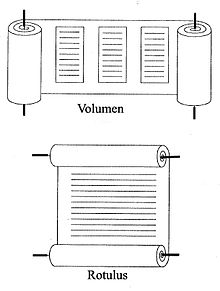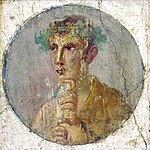
The codex was the historical ancestor of the modern book. Instead of being composed of sheets of paper, it used sheets of vellum, papyrus, or other materials. The term codex is often used for ancient manuscript books, with handwritten contents. A codex is bound by stacking the pages and securing one set of edges, in a form analogous to modern bookbinding. Modern books are divided into paperback and those bound with stiff boards, called hardbacks. Elaborate historical bindings are called treasure bindings. At least in the Western world, the main alternative to the paged codex format for a long document was the continuous scroll, which was the dominant form of document in the ancient world. Some codices are continuously folded like a concertina, in particular the Maya codices and Aztec codices, which are actually long sheets of paper or animal skin folded into pages. In Japan, concertina-style codices called orihon developed during the Heian period (794–1185) were made of paper.

A manuscript was, traditionally, any document written by hand or typewritten, as opposed to mechanically printed or reproduced in some indirect or automated way. More recently, the term has come to be understood to further include any written, typed, or word-processed copy of an author's work, as distinguished from the rendition as a printed version of the same.
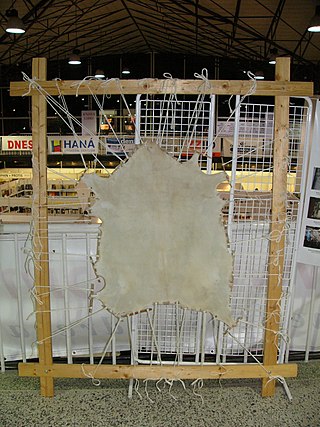
Parchment is a writing material made from specially prepared untanned skins of animals—primarily sheep, calves, and goats. It has been used as a writing medium for over two millennia. Vellum is a finer quality parchment made from the skins of young animals such as lambs and young calves.

Papyrus is a material similar to thick paper that was used in ancient times as a writing surface. It was made from the pith of the papyrus plant, Cyperus papyrus, a wetland sedge. Papyrus can also refer to a document written on sheets of such material, joined side by side and rolled up into a scroll, an early form of a book.
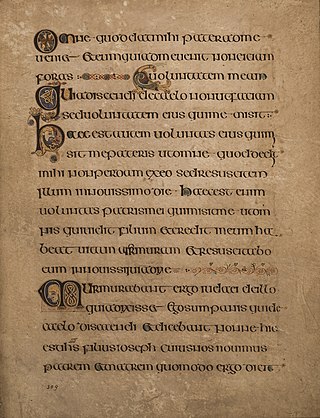
Uncial is a majuscule script commonly used from the 4th to 8th centuries AD by Latin and Greek scribes. Uncial letters were used to write Greek and Latin, as well as Gothic, and are the current style for Coptic and Nobiin.
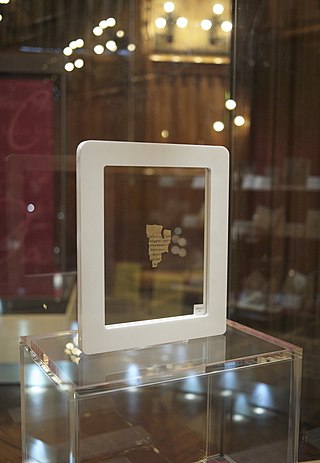
The Rylands Library Papyrus P52, also known as the St John's fragment and with an accession reference of Papyrus Rylands Greek 457, is a fragment from a papyrus codex, measuring only 3.5 by 2.5 inches at its widest, and conserved with the Rylands Papyri at the John Rylands University Library Manchester, UK. The front (recto) contains parts of seven lines from the Gospel of John 18:31–33, in Greek, and the back (verso) contains parts of seven lines from verses 37–38. Since 2007, the papyrus has been on permanent display in the library's Deansgate building.

A scroll, also known as a roll, is a roll of papyrus, parchment, or paper containing writing.

The history of books became an acknowledged academic discipline in the 1980s. Contributions to the field have come from textual scholarship, codicology, bibliography, philology, palaeography, art history, social history and cultural history. Its key purpose is to demonstrate that the book as an object, not just the text contained within it, is a conduit of interaction between readers and words. Analysis of each component part of the book reveals its purpose, where and how it was kept, who read it, ideological and religious beliefs of the period, and whether readers interacted with the text within. Even a lack of evidence of this nature leaves valuable clues about the nature of that particular book.

A cartulary or chartulary, also called pancarta or codex diplomaticus, is a medieval manuscript volume or roll (rotulus) containing transcriptions of original documents relating to the foundation, privileges, and legal rights of ecclesiastical establishments, municipal corporations, industrial associations, institutions of learning, or families. The term is sometimes also applied to collections of original documents bound in one volume or attached to one another so as to form a roll, as well as to custodians of such collections.

The Joshua Roll is a Byzantine illuminated manuscript of highly unusual format, probably of the 10th century Macedonian Renaissance, believed to have been created by artists of the imperial workshops in Constantinople, and now in the Vatican Library.
A biblical manuscript is any handwritten copy of a portion of the text of the Bible. Biblical manuscripts vary in size from tiny scrolls containing individual verses of the Jewish scriptures to huge polyglot codices containing both the Hebrew Bible (Tanakh) and the New Testament, as well as extracanonical works.

Papyrus 75, designated by the siglum 𝔓75, is an early Greek New Testament manuscript written on papyrus. It contains text from the Gospel of Luke 3:18–24:53, and John 1:1–15:8. It is generally described as "the most significant" papyrus of the New Testament to be discovered so far. Using the study of comparative writing styles (palaeography), it has been traditionally dated to the third century. It is due to this early dating that the manuscript has a high evaluation, and the fact its text so closely resembles that of the fourth-century Codex Vaticanus (B).
A mortuary roll was a rotulus composed in the scriptorium of a medieval Christian monastic community to commemorate the death of a prominent person associated with the institution.
Codex Vaticanus Graecus 2061, usually known as Uncial 048, α1 (Soden), is a Greek uncial manuscript on parchment. It contains some parts of the New Testament, homilies of several authors, and Strabo's Geographica. Formerly it was known also as the Codex Basilianus 100, earlier as Codex Patriniensis 27. It was designated by ב a, p.
Constantine Simonides (1820–1867) was a Greek palaeographer and dealer of icons, with knowledge of manuscripts and calligraphy. He was one of the most versatile forgers of the nineteenth century.

Minuscule 33, δ 48 (Soden), before the French Revolution was called Codex Colbertinus 2844. It is a Greek minuscule manuscript of the New Testament on parchment, dated palaeographically to the 9th century. The manuscript is lacunose. It has marginalia. According to the textual critics it is one of the best minuscule manuscripts of the New Testament.

The Liturgy of Saint Cyril is one of the three Anaphoras used at present by the Coptic Catholic Church and the Coptic Orthodox Church and it retains the liturgical peculiarities which have originated in the early Christian Egypt, thus forming the core of the historical Alexandrian Rite. When reference is made to its Greek Byzantine Rite version, this text is usually known as Liturgy of Saint Mark.

A scroll is a roll of papyrus, parchment, or paper containing writing. The history of scrolls dates back to ancient Egypt. In most ancient literate cultures scrolls were the earliest format for longer documents written in ink or paint on a flexible background, preceding bound books; rigid media such as clay tablets were also used but had many disadvantages in comparison. For most purposes scrolls have long been superseded by the codex book format, but they are still produced for some ceremonial or religious purposes, notably for the Jewish Torah scroll for use in synagogues.
The Record Commissions were a series of six Royal Commissions of Great Britain and the United Kingdom which sat between 1800 and 1837 to inquire into the custody and public accessibility of the state archives. The Commissioners' work paved the way for the establishment of the Public Record Office in 1838. The Commissioners were also responsible for publishing various historical records, including the Statutes of the Realm to 1714 and the Acts of Parliament of Scotland to 1707, as well as a number of important medieval records.

An Exultet roll is a long and wide illuminated scroll containing the text and music of the Exultet, the liturgical chant for the Paschal vigil. The material was usually parchment, the layout that of a rotulus, the text in Beneventan script and the music notated in neumes. The illustrations were often upside down relative to the text. As the text was read by the officiant and the scroll unrolled over the pulpit (ambo), the images would appear right-side up to the congregation. The form was peculiar to southern Italy, mainly the area around Benevento and Montecassino, and the surviving examples date from between the 10th and 13th centuries.
